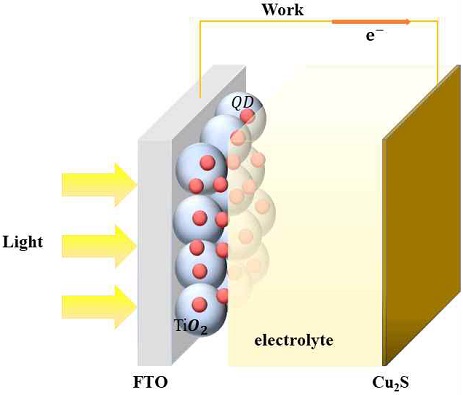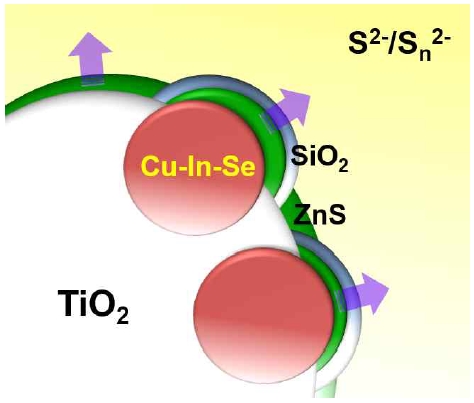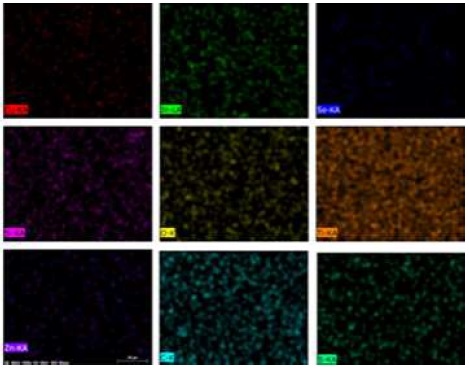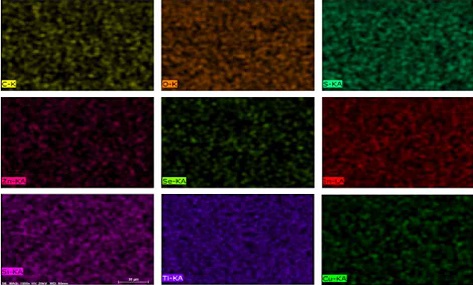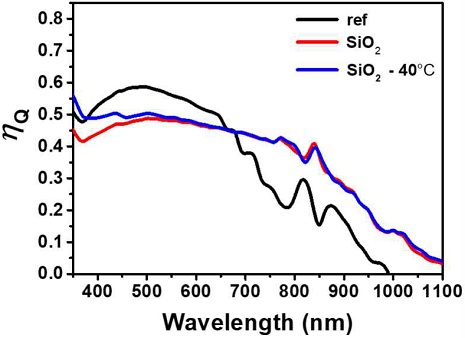
양자점 감응 태양전지의 광전 특성 향상을 위한 ZnS/SiO2 이중 오버레이어 개발
2021 The Korean Hydrogen and New Energy Society. All rights reserved.
Abstract
For the high efficiencies of quantum dot-sensitized solar cells (QDSCs), it is important to control the severe electron recombination at the interface of photoanode/electrolyte. In this work, we optimize the surface passivation process of ZnS/SiO2 double overlayers for the enhanced photovoltaic performances of QDSCs. The overlayers of zinc sulfide (ZnS) and SiO2 are coated on the surface of QD-sensitized photoanode by successive ionic layer adsorption and reaction (SILAR) method, and sol-gel reaction, respectively. In particular, for the sol-gel reaction of SiO2, the influences of temperature of precursor solution are investigated. By application of SiO2 overlayers on the ZnS-coated photoanode, the conversion efficiency of QDSCs is increased from 5.04% to 7.35%. The impedance analysis reveals that the electron recombination at the interface of photoanode/electrolyte is obviously reduced by the SiO2 overlayers.
Keywords:
Quantum dot-sensitized solar cells, Overlayers, SiO2, Photoanode키워드:
양자점 감응 태양전지, 오버레이어, 이산화규소, 광전극1. 서 론
친환경에너지의 중요성이 더욱 강조되고 있는 지금 태양광 발전은 여러 친환경에너지 중에 많은 관심을 받고 있는 분야이다. 기존 결정질 실리콘 태양전지는 높은 제작 비용, 정교한 공정의 필요 등의 요인으로 인하여 충분히 활용되지 못하고 있다. 따라서 지난 수년 동안 이를 대체할 박막 태양전지, 유기 태양전지, 염료 감응 태양전지, 페로브스카이트 태양전지, 양자점 태양전지 등 여러 차세대 태양전지가 연구되어 왔다1-5). 이 중 양자점 감응 태양전지(quantum dot-sensitized solar cells, QDSCs)는 저비용, 간단한 공정이라는 이점이 있어 활발하게 연구가 진행되고 있다6,7). 그러나 양자점 감응 태양전지의 광변환 효율은 아직까지 상용화 수준에 미치지 못하고 있다.
양자점 감응 태양전지의 효율을 높이는 방안으로 광전극과 전해질 계면 사이에서 일어나는 전자 재결합을 줄이는 방안에 대해서 활발히 연구가 진행되고 있다8-10). 가장 일반적으로 zinc sulfide (ZnS) 오버레이어(overlayers) 등을 successive ionic layer adsorption and reaction (SILAR)에 의해 광전극 표면에 코팅하여 전해질 내 산화환원쌍과의 전자 재결합을 줄이는 방식이 효과적인 방법으로 알려져 있다11). 또한 ZnS오버레이어와 함께 sol-gel 반응에 의한 SiO2 코팅을 함께 적용하여 전자 재결합을 더욱 감소시키는 연구도 보고된 바 있다12,13). 그에 대한 예로, Du 등14)은 SILAR에 의한 ZnS 오버레어어 및 sol-gel 반응에 의한 SiO2 코팅을 적용하여 양자점 태양전지로 11.6%의 효율을 기록하였다. 또한, Song 등15)은 SILAR에 의한 ZnS 오버레어어를 적용하여 양자점 태양전지로 14.4%의 효율을 기록하였다. 본 연구에서는 Cu-In-Se (CISe) 양자점을 활용한 무독성 양자점 감응 태양전지에 ZnS/SiO2 이중 오버레이어를 적용하고, 이에 따른 태양전지의 광전특성을 관찰하였다. 특별히, sol-gel 반응에 의한 SiO2 코팅 시 용액의 온도 변화에 따른 영향을 분석하였다.
2. 실 험
2.1 재료
Fluorine tin oxide (FTO) 기판(TEC-8, Pilkington, 8 Ω/sq)을 1.5×2.0 cm2 크기로 절단하여 아세톤과 에탄올 용액에 15분 동안 초음파 세척하였다. 세척된 FTO 기판은 자외선/오존 클리너(ultraviolet, UV/ozone cleaner, Yuil UltraViolet System, YUILUV. Co., Ltd., Incheon, Korea)를 사용해 15분 동안 처리해주었다. 그 뒤 FTO 기판 위에, 7.5 wt% Ti (IV) bis (ethylacetoacetato)-diisopropoxide (Aldrich, St louis, MO, USA)를 n-butanol (Deajung, Siheung, Korea)에 녹인 용액을 스핀 코팅한 뒤, 박스형 퍼니스에서 450℃, 10분 조건으로 열처리하였다. 그후, TiO2 나노입자 페이스트(Ti-Nanoxide T/SP, Solaronix S.A., Aubonne, Switzerland) 및 산란층 페이스트(Ti-Nanoxide R/SP, SOLARONIX)를 Doctor blading 기법으로 순차적으로 증착하였다15). 이후 박스형 퍼니스에서 150℃에서 10분, 250℃에서 10분, 400℃에서 10분, 마지막으로 500℃에서 30분으로 온도를 높여가며 고온 소성하였다.
2.2 양자점 흡착 및 오버레이어 코팅
메조포러스 TiO2 필름에 양자점을 흡착시키기 위해, 고온 소성 후 CISe quantum dot (QD) 분산액에 24시간 동안 침지하였다. 이후 TiO2/QD 전극을 dichloromethane으로 세척하고 질소로 건조시켰다. 다음으로 SILAR 방법을 통해 ZnS 오버레이어를 코팅하였다16). 이것은 0.05 M Zn(NO3)2∙6H2O (Aldrich) 에탄올 용액 및 0.05 M Na2S (Aldrich) 메탄올/증류수 용액에 순차적으로 각각 1분간 침지하는 방식이다. 이 SILAR 과정을 3회 반복하였다. SiO2 오버레이어 코팅을 위해 에탄올 100 mL에 tetraethyl orthoslicate (Aldrich) 230 µL을 넣어준 다음에 NH4OH (Supelco®, Supelco, St louis, MO, USA) 1,800 µL을 첨가하여 용액을 준비하였다. 이 용액에 TiO2/QD/ZnS 전극을 1시간 동안 침지시켰다. 이 때, SiO2 전구체 용액의 온도를 실온 또는 40℃로 유지하였다.
2.3 태양전지 제작
Cu2S 상대전극은 황동 필름(0.25 mm 두께, Alfa Aesar, Haveril, MA, USA)을 80℃에서 30분 동안 35-37 wt% HCl 수용액에 침지하여 준비하였다. 에칭된 황동 필름을 증류수로 세척하고 압축공기를 통해 건조시켰다. 이후 Cu2S 층을 형성하기 위해서 polysulfide 수용액에 10분 동안 침지한 뒤 증류수로 세척하고 압축공기를 이용하여 건조시켰다17). 침지용액으로 사용되는 polysulfide 수용액은 2 M sodium sulfide (Sigma Aldrich, St louis, MO, USA), 2 M sulfur (Sigma Aldrich)를 증류수에 녹여 제조하였다. QD가 코팅된 광전극을 polyimide (PI) 양면테이프를 사용하여 Cu2S 상대전극과 결합시켰다. 전해질로 사용되는 polysulfide 용액은 2 M sodium sulfide, 2 M sulfur, 0.2 M potassium chloride (Sigma Aldrich), 5 wt% polyvinylpyrrolidone (Alfa Aesar)을 증류수에 녹여 제조하였다18). 제조된 전해질은 광전극 기판에 뚫은 구멍을 통해 주입하고, PI 테이프를 이용하여 두 구멍을 밀봉하였다.
2.4 분석
제작된 QDSC의 임피던스 데이터 및 J-V curve는 일정전위기(Potentiostat, M204, Metrohm Autolab BV, Utrecht, Netherlands)를 이용하여 분석하였다. 태양전지에 조사되는 광은 AM 1.5 G 조건으로 설정된 solar simulator (PEC-L01, Peccell Technologies, Inc., Kawasaki, Japan)를 이용하였다. 제작된 광전극의 표면은 주사 전자현미경(SEM, S-4700, HITACHI, Tokyo, Japan)을 사용하여 관찰하였으며, 에너지 분산형 X-선 분광분석기 (Energy Dispersive X-ray Spectroscopy, EDS, Bruker AXS Quantax 4010, HITACHIl)를 사용하여 원소 조성을 관찰하였다. Incident-photon-to-electron conversion efficiency (IPCE)는 Xe lamp (300-1000W, Newport, Irvine, CA, USA), detector 및 monochromator (Oriel instrument, Newport)를 통해 측정하였다.
3. 결과 및 고찰
Fig. 1은 QDSC의 소자구조를 보여준다. 광 조사시에 TiO2 전극에 흡착된 QD가 광전자를 방출시키고, 광전자는 TiO2 conduction band로 주입되어 외부도선을 향해 흐르게 된다. 전자를 잃은 QD는 전해질의 산화환원쌍에 의해 환원되고, 전해질 산화환원쌍은 상대전극으로 전달된 전자에 의해 환원되는 사이클을 통해 소자가 구동된다.
Fig. 2는 ZnS/SiO2 이중 오버레이어를 나타내는 그림이다. 본 연구에서는 CISe QD가 흡착된 TiO2 전극 표면에 ZnS 층과 SiO2 층을 순차적으로 코팅하였다. 그림에 표현된 바와 같이 광전극과 전해질 내 산화환원쌍 간의 전자재결합을 이중 오버레이어가 감소시킬 것을 의도하여 적용하였다19). 또한, 특별히 SiO2 층 코팅 시, 전구체 용액의 온도를 실온 또는 40℃로 유지하여 온도에 대한 영향을 관찰하였다.
Fig. 3은 기존 방법대로 ZnS/SiO2 이중 오버레이어를 코팅한 TiO2/CISe QD 광전극의 EDS mapping 이미지이다. SiO2 코팅 시 전구체 용액 온도를 실온으로 유지한 경우이다. Fig. 3에서 보듯이 각 구성 원소들이 균일하게 평면상에 분포함을 알 수 있다. 이는 이중 오버레이어 층이 비교적 균일하게 코팅되었기 때문이다. 각 원소 간의 상대적 비율은 Table 1에서 볼 수 있다. Fig. 4는 변화시킨 방법으로 ZnS/SiO2 이중 오버레이어를 코팅한 TiO2/CISe QD 광전극의 EDS mapping 이미지이다. 이 경우 SiO2 코팅 시 전구체 용액 온도를 40℃로 유지하였다. 각 원소 간의 상대적 비율은 Table 2에서 볼 수 있다. 이 경우도 마찬가지로 이중 오버레이어 층이 비교적 균일하게 코팅되었다고 판단할 수 있다.

Relative concentration for each element of the TiO2/CISe/ZnS/SiO2 photoanode prepared by a standard process

Relative concentration for each element of the TiO2/CISe/ZnS/SiO2 photoanode prepared by a modified process
이렇게 표면 처리한 광전극을 기반으로 QDSC를 제작하였으며, 표면 처리 조건에 따른 J-V 곡선은 Fig. 5에 나타나 있다. 또한 이와 관련한 매개변수는 Table 3에 정리되어 있다. 광전극에 ZnS 오버레이어만 코팅할 때에 비해 SiO2를 함께 코팅할 시 short-circuit current density (JSC) 값이 크게 향상되어 광변환 효율이 증가함을 관찰할 수 있었다. 특히, SiO2 코팅 시, JSC 값과 광변환 효율이 추가적으로 향상됨을 알 수 있다. 이는 SiO2 코팅을 위한 sol-gel 반응 시 일정 이상의 열에너지를 가하는 것이 더 효과적임을 말해준다. Fig. 6에서 보듯이 IPCE 값 또한 ref 조건 대비 이중 오버레이어 적용 시 전반적으로 향상됨을 알 수 있다.
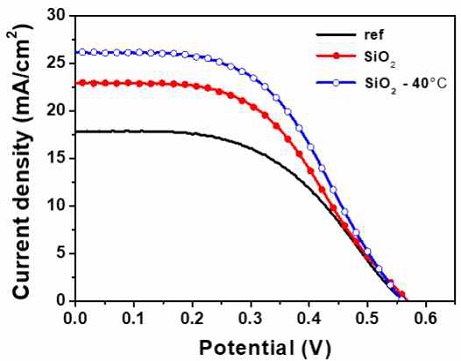
Photocurrent density-voltage (J-V) characteristics of QDSCs according to the method of surface modification
이중 오버레이어에 의한 광전극 표면 전자재결합 감소를 직접적으로 관찰하기 위하여 임피던스 분석을 진행하였다20-22). Fig. 7은 QDSC의 VOC에 근접한 –0.6 V로 직류 전압을 가하며 얻은 임피던스 스펙트럼이다. 주파수 범위는 0.1 Hz에서 100 kHz로 설정하였으며, sinusoidal pertubation은 10 mV 조건으로 가하였다. 이를 Fig. 7에 보이는 등가회로를 사용하여 Zview 프로그램에서 피팅하였다. 광전극과 전해질 사이 계면에서 일어나는 전하전달 저항은 등가회로의 Rct 값으로 나타나는데, 피팅 결과 ZnS 오버레이어만 적용했을 시 (ref) Rct 값이 13.08 Ω·cm2인데 반해 이중 오버레이어를 적용했을 시 Rct 값이 14.46 Ω·cm2로 다소 증가하였다. 이는 이중 오버레이어가 광전극 표면에서의 전자 재결합을 더 효과적으로 감소시켜줌을 말해준다. 이러한 전자재결합 감소가 태양전지의 전반적인 광전 특성 향상 및 광변환 효율 증가로 이어졌음을 알 수 있다.
4. 결 론
본 연구에서는 ZnS/SiO2 이중 오버레이어를 적용한 CISe 양자점 감응 태양전지의 광전 특성 분석을 진행하였다. ZnS 단일 오버레이어와 비교하여 SiO2를 함께 이중 오버레이어로 적용한 경우 5.04%에서 7.35%로 광변환 효율이 향상되었음을 보였다. 특히, SiO2 코팅을 위한 sol-gel 반응 시 전구체 용액의 온도를 높인 경우, 실온에서 반응시킨 경우에 비해 더 향상된 광전 특성을 나타내었다. 또한, 이중 오버레이어가 광전극/전해질 계면에서 발생하는 전자 재결합을 억제하였음을 임피던스를 통해 알 수 있었으며, 이것이 태양전지 성능 향상의 주요한 요인으로 판단되었다.
References
- K. Takahashi and M. Konagai, “Amorphous silicon solar cells”, Wiley, 1986, pp. 237. Retrieved from https://ui.adsabs.harvard.edu/abs/1986wi...bookR....T/abstract, .
-
P. Peumans, A. Yakimov, and S. R. Forrest, “Small molecular weight organic thin-film photodetectors and solar cells”, Journal of Applied Physics, Vol. 93, No. 7, 2003, pp. 3693-3723.
[https://doi.org/10.1063/1.1534621]

-
K. Yoo, J. Y. Kim, J. A. Lee, J. S. Kim, D. K. Lee , K. Kim, J. Y. Kim, B. Kim, H. Kim, W. M. Kim, J. H. Kim, M. J. Ko, and M. J. Ko, “Completely transparent conducting oxide-free and flexible dye-sensitized solar cells fabricated on plastic substrates”, ACS NANO, Vol. 9, No. 4, 2015, pp. 3760-3771.
[https://doi.org/10.1021/acsnano.5b01346]

-
J. W. Jo, M. S. Seo, M. Park, J. Y. Kim, J. S. Park, I. K. Han, H. Ahn, J. W. Jung, B. Sohn, M. J. Ko, and H. J. Son, “Improving performance and stability of flexible planar‐heterojunction perovskite solar cells using polymeric hole‐transport material”, Advanced Functional Materials, Vol. 26, No. 25, 2016, pp. 4464-4471.
[https://doi.org/10.1002/adfm.201600746]

-
J. S. Kang, M. A. Park, J. Y. Kim, S. H. Park, D. Y. Chung, S. H. Yu, J. Kim, J. Park, J. Choi, K. J. Lee, J. Jeong, M. J. Ko, K. Ahn, and Y. E. Sung, “Reactively sputtered nickel nitride as electrocatalytic counter electrode for dye-and quantum dot-sensitized solar cells”, Scientific Reports, Vol. 5, 2015.
[https://doi.org/10.1038/srep10450]

-
W. T. Sun, Y. Yu, H. Y. Pan, X. F. Gao, Q. Chen, and L. M. Peng, “CdS quantum dots sensitized TiO2 nanotube-array photoelectrodes”, Journal of the American Chemical Society, Vol. 130, No. 4, 2008, pp. 1124-1125.
[https://doi.org/10.1021/ja0777741]

-
Y. Tachibana, H. Y. Akiyama, Y. Ohtsuka, T. Torimoto, and S. Kuwabata, “CdS quantum dots sensitized TiO2 sandwich type photoelectrochemical solar cells”, Chemistry Letters, Vol. 36, No. 1, 2007, pp. 88-89.
[https://doi.org/10.1246/cl.2007.88]

-
W. Lee, J. Lee, S. Lee, W. Yi, S. H. Han, and B. W. Cho, “Enhanced charge collection and reduced recombination of CdS/Ti O2 quantum-dots sensitized solar cells in the presence of single-walled carbon nanotubes”, Applied Physics Letters, Vol. 92, 2008, pp. 153510.
[https://doi.org/10.1063/1.2911740]

-
J. Tian and G. Cao, “Control of nanostructures and interfaces of metal oxide semiconductors for quantum-dots-sensitized solar cells”, The Journal of Physical Chemistry Letters, Vol. 6, No. 10, 2015, pp. 1859-1869.
[https://doi.org/10.1021/acs.jpclett.5b00301]

-
Z. Li, Y. F. Wang, X. W. Wang, Z. Yang, and J. H. Zeng, “Doping as an effective recombination suppressing strategy for performance enhanced quantum dots sensitized solar cells”, Materials Letters, Vol. 221, 2018, pp. 42-45.
[https://doi.org/10.1016/j.matlet.2018.03.058]

-
Z. Li, L. Tu, H. Wang, H. Yang, and H. Ma, “TiO2 passivation layer on ZnO hollow microspheres for quantum dots sensitized solar cells with improved light harvesting and electron collection”, Nanomaterials, Vol. 10, No. 4, 2020, pp. 631.
[https://doi.org/10.3390/nano10040631]

-
T. V. Nguyen, H. C. Lee, M. A. Khan, and O. B. Yang, “Electrodeposition of TiO2/SiO2 nanocomposite for dye-sensitized solar cell”, Solar Energy, Vol. 81, No. 4, 2007, pp. 529-534.
[https://doi.org/10.1016/j.solener.2006.07.008]

-
Y. Wang, J. Zhai, Y. Song, J. Lin, P. Yin, and L. Guo, “Interfacial effect of novel core-triple shell structured Au@SiO2@Ag@ SiO2 with ultrathin SiO2 passivation layer between the metal interfaces on efficient dye‐sensitized solar cells”, Advanced Materials Interfaces, Vol. 2, No. 17, 2015, pp. 1500383.
[https://doi.org/10.1002/admi.201500383]

-
J. Du, Z. Du, J. S. Hu, Z. Pan, Q. Shen, J. Sun, D. Long, H. Dong, L. Sun, X. Zhong, and L. J. Wan, “Zn-Cu-In-Se quantum dot solar cells with a certified power conversion efficiency of 11.6%”, Journal of the American Chemical Society, Vol. 138, No. 12, 2016, pp. 4201-4209.
[https://doi.org/10.1021/jacs.6b00615]

-
H. Song, Y. Lin, M. Zhou, H. Rao, Z. Pan, and X. Zhong, “Zn‐Cu‐In‐S‐Se quinary “Green” alloyed quantum‐dot‐sensitized solar cells with a certified efficiency of 14.4%”, Angewandte Chemie, Vol. 133, No. 11, 2020, pp. 6202-6209.
[https://doi.org/10.1002/ange.202014723]

-
L. Yue, H. Rao, J. Du, Z. Pan, J. Yu, and X. Zhong, “Comparative advantages of Zn-Cu-In-S alloy QDs in the construction of quantum dot-sensitized solar cells”, RSC Advances, Vol. 8, 2018, pp. 3637-3645.
[https://doi.org/10.1039/C7RA12321C]

-
K. Mng, P. K. Surolia, O. Byrne, and K. R. Thampi, “Efficient CdS quantum dot sensitized solar cells made using novel Cu2S counter electrode”, Journal of Power Sources, Vol. 248, 2014, pp. 218-223.
[https://doi.org/10.1016/j.jpowsour.2013.09.004]

-
M. Zhou, G. Shen, Z. Pan, and X. Zhong, “Selenium cooperated polysulfide electrolyte for efficiency enhancement of quantum dot-sensitized solar cells”, Journal of Energy Chemistry, Vol. 38, 2018.
[https://doi.org/10.1016/j.jechem.2018.12.010]

-
J. Y. Kim, J. Yang, J. H. Yu, W. Beak, C. H. Lee, H. J. Son, T. Hyeon, and M. J. Ko, “Highly efficient copper-indium-selenide quantum dot solar cells: suppression of carrier recombination by controlled ZnS overlayers”, ACS Nano, Vol. 9, 2015, pp. 11286-11295.
[https://doi.org/10.1021/acsnano.5b04917]

-
T. Hoshikawa, M. Yamada, R. Kikuchi, and K. Eguchi, “Impedance analysis of internal resistance affecting the photoelectrochemical performance of dye-sensitized solar cells”, Journal of the Electrochemical Society, Vol. 152, No. 2, 2005, pp. E68.
[https://doi.org/10.1149/1.1849776]

-
E. Ramasamy, W. J. Lee, D. Y. Lee, and J. S. Song, “Spray coated multi-wall carbon nanotube counter electrode for tri-iodide(I3-) reduction in dye-sensitized solar cells”, Electrochemistry Communications, Vol. 10, No. 7, 2008, pp. 1087-1089.
[https://doi.org/10.1016/j.elecom.2008.05.013]

-
A. Guerrero, S. Loser, G. Garcia-Belmonte, C. J. Bruns, J. Smith, H. Miyauchi, S. I. Stupp, J. Bisquert, and T. J. Marks, “Solution-processed small molecule: fullerene bulk-heterojunction solar cells: impedance spectroscopy deduced bulk and interfacial limits to fill-factors”, Physical Chemistry Chemical Physics, Vol. 39, No. 15, 2013, pp. 16456-16462.
[https://doi.org/10.1039/c3cp52363b]

